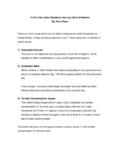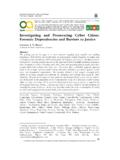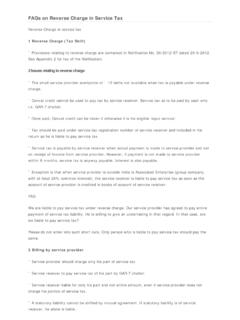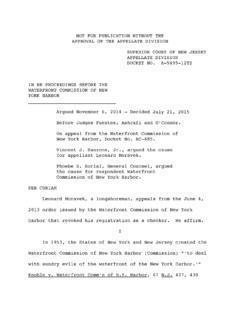Transcription of Agency Liability Issues for Police K-9
1 Agency Liability Issues for Law Enforcement K-9 By Terry Fleck I m often asked by Agency supervisors and administrators about their Liability exposure when they supervise or administrate a K-9 unit. Upon review of both Federal and State law suits where a K-9 handler and his Agency is sued, typically for excessive K-9 force, there is definitive Liability upon Agency supervisors and administrators. Agency Liability is based upon two legal doctrines: 1. Respondeat Superior: An employer is responsible for the actions of employees performed within the course of their employment. Employer/employee relationships are the most common area wherein respondeat superior is applied, but often the doctrine is used in the Agency relationship. In this, the principal becomes liable for the actions of the agent, even if the principal did not directly commit the act.
2 There are three considerations generally: A. Was the act committed within the time and space limits of the Agency ? B. Was the offense incidental to, or of the same general nature as, the responsibilities the agent is authorized to perform? C. Was the agent motivated to any degree to benefit the principal by committing the act? 2. Vicarious Liability : The legal dictionary definition: The imposition of Liability on one person for the actionable conduct of another, based solely on a relationship between the two persons. Indirect or imputed legal responsibility for acts of another; for example, the Liability of an employer for the acts of an employee. There are generally eight Liability areas that are addressed within these two legal doctrines: 1.
3 NEGLIGENT APPOINTMENT or FAILURE TO APPOINT: There are two components of a K-9 team, the handler and the dog. Handler Selection: A. First, there must be a written Agency K-9 policy; B. Second, there must be a selection process standard. As an example, this is from the State of California K-9 Standard: The following guidelines are recommended for consideration in the selection of a K-9 handler. Strong character traits such as: Maturity Patience Initiative Flexibility Dependability Enthusiasm Emotional stability Communication skills (verbal and written) Good physical condition Good physical health Should be comfortable with and have an understanding of dogs Good interpersonal relationships with the public and other employees Home life should be compatible with canine Possess a (Peace Officers Standards and Training) Basic Certificate C.
4 Lastly, there should an oral board for the selection of the best qualified applicant. Dog Selection: A. This is probably the most important decision an Agency will make in their K-9 program. B. The dog must be genetically predisposed to be able to handle stress. In order to insure the dog s stability under stress, some things to consider are: Sending two people to evaluate the dog: First, the trainer, who needs to be well based in animal behavior and the handler, as he will be actually working that dog; Testing multiple dogs at multiple vendors; Testing at neutral locations; Using some form of a stress test , sometimes referred to as a stake out test ; Hunt (predatory) behavior testing; Social behavior testing; Social aggression testing; History or background of the dog; Lastly, physical testing by a veterinarian.
5 2. NEGLIGENT RETENTION or FAILURE TO RETAIN: Monthly review of the K-9 Team: Review of all training; Review of current yearly certification; Review of all deployments; Review of the team s physical and mental stability. 3. NEGLIGENT ENTRUSTMENT or FAILURE to ENTRUST: The entrustment of the K-9 to the handler: Entrustment of a K-9 (a potential use of force) to an officer who is not physically or mentally fit. 4. NEGLIGENT ASSIGNMENT or FAILURE TO ASSIGN: The use of K-9 out-of-scope: The Graham v Connor objective reasonableness standard as a use of K-9 force (patrol dogs); Exceeding the dog s capability, such as: o Turning a call into a K-9 call. o Using a K-9 in any application, where the dog has not received training in that application.
6 O Using a Narcotic Detector Dog for Police Service Dog person searches (using a dog out-of-scope). Unavailability / availability of K-9: o The tool (K-9) should be both available and utilized. 5. NEGLIGENT DIRECTION or FAILURE TO DIRECT: On-scene supervision or supervision knowledge of a K-9 deployment; Deployment consistent with written Agency K-9 policy; A Police Service Dog handler shall have the ultimate authority not to deploy the dog. The handler will evaluate each situation and determine if the use of a Police Service Dog is technically feasible. Generally the decision to deploy the dog shall remain with the handler; however, a supervisor sufficiently apprised of the situation may decide not to deploy the dog. 6. NEGLIGENT TRAINING or FAILURE TO TRAIN: There are three Issues : Standards, Training and Certification: Standards: There are currently only about fourteen (14) States that have a K-9 Standard and Certification.
7 Only two (2) of those States actually mandate and enforce it. If your State does not have a State K-9 standard, the Agency may: o Use another State s K-9 Standard; o Use a nationally recognized K-9 standard, such as a K-9 association standard. The Federal government has identified the lack of State K-9 standards and certification and therefore, has gotten involved in creating the consensus-based best practice guidelines for the K-9 industry. The Scientific Working Group on Dog and Orthogonal Detector Guidelines (SWGDOG) was recently formed to address this task. The Scientific Working Group on Dog and Orthogonal Detector Guidelines (SWGDOG) is a forum aimed at addressing the broadly expressed need to improve the performance, reliability, and courtroom defensibility of detector dog teams.
8 It is also charged with recommending best approaches to the use of detector dogs in conjunction with electronic detection devices, or so-called orthogonal detectors. Modeled after the successful precedent of a variety of other scientific working groups, SWGDOG aims to develop internationally recognized consensus-based best practice guidelines developed by a membership of respected scientists, practitioners, and policy makers representing diverse backgrounds within the detection community. SWGDOG guidelines will be made available to the public via the SWGDOG website at SWGDOG is funded by the National Institute of Justice, Federal Bureau of Investigation, and the Transportation Security Administration. SWGDOG Subcommittees: o Unification of terminology o Protocols and documentation for minimum training, certification, and maintenance standards (Substances, scent) o Selection of serviceable dogs and replacement systems o Kenneling, keeping, and health care o Selection and training of handlers and instructors o Procedures on presenting evidence in court o Research and technology o Substance detector dogs (Agriculture, Arson, Chem.)
9 / Bio., Drugs, Explosives, Human Remains, other / misc. o Scent dogs (Scent Identification, Search and Rescue, Trailing Dogs, Tracking Dogs) Training: Training to the standard. The United States canine industry standard for K-9 maintenance training is a minimum of sixteen hours per month (four hours per week, on average) per K-9 team. This standard was developed and is currently endorsed by the three largest United States Police canine associations: USPCA (United States Police Canine Association), NAPWDA (North American Police Work Dog Association) and NPCA (National Police Canine Association). The recommended minimum applies to each K-9 team, not per K-9 discipline. In other words, the minimum standard applies to a sole purpose dog and/or a cross trained, multi-discipline dog.
10 Common sense would dictate that it will take longer to maintain a cross trained, multi-discipline dog. Remember, this is a MINIMUM standard. If an Agency elected to be below this minimum canine industry standard, and thus in violation with this standard, there is probable Liability in two areas: o Liability for failure to train and failure to supervise; o Liability for being deliberately indifferent to the training needs of a specialized law enforcement unit, K-9. I have personally polled about 21,000 Police dog handlers, supervisors and administrators throughout the since 1995. Almost 100% (99% +) of our Police K-9 industry is in compliance with the minimum standard for Police K-9 maintenance training. That is significant, since it not only corroborates the standard, but also shows our industry follows it and endorses it.







